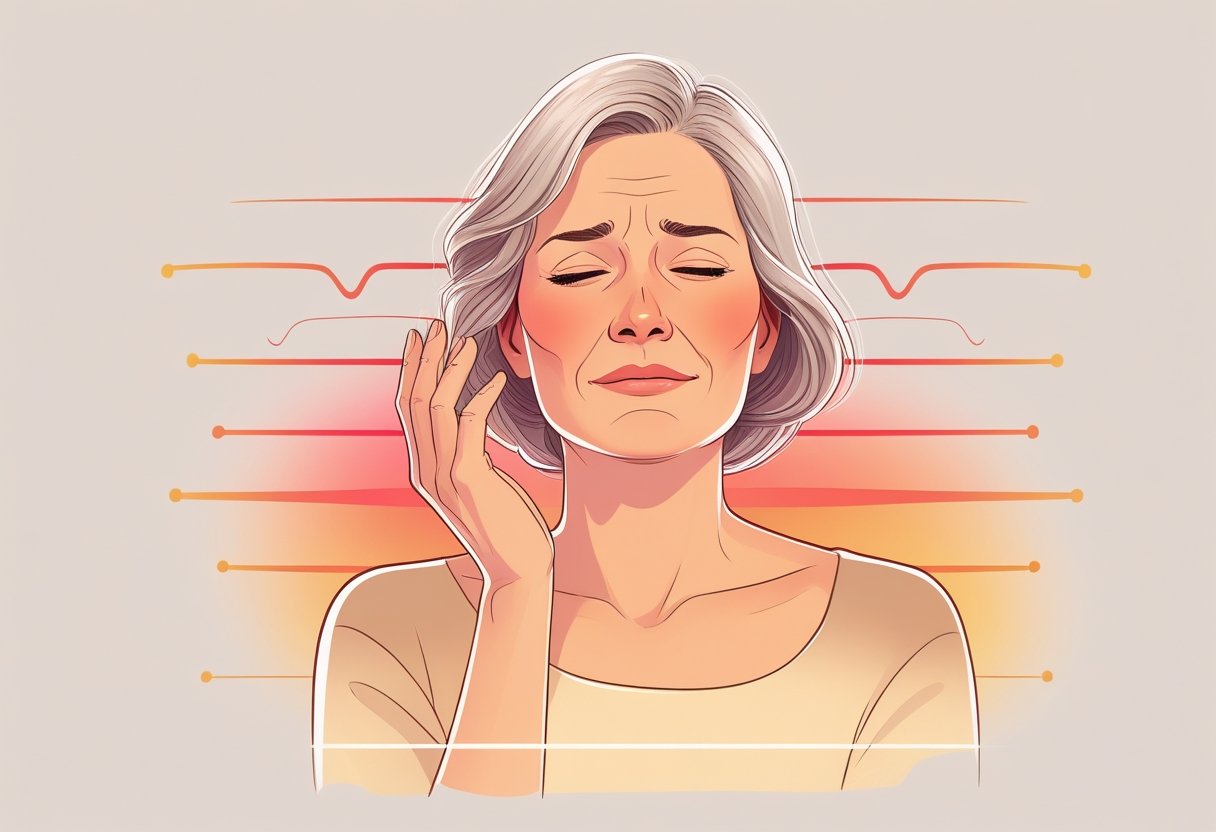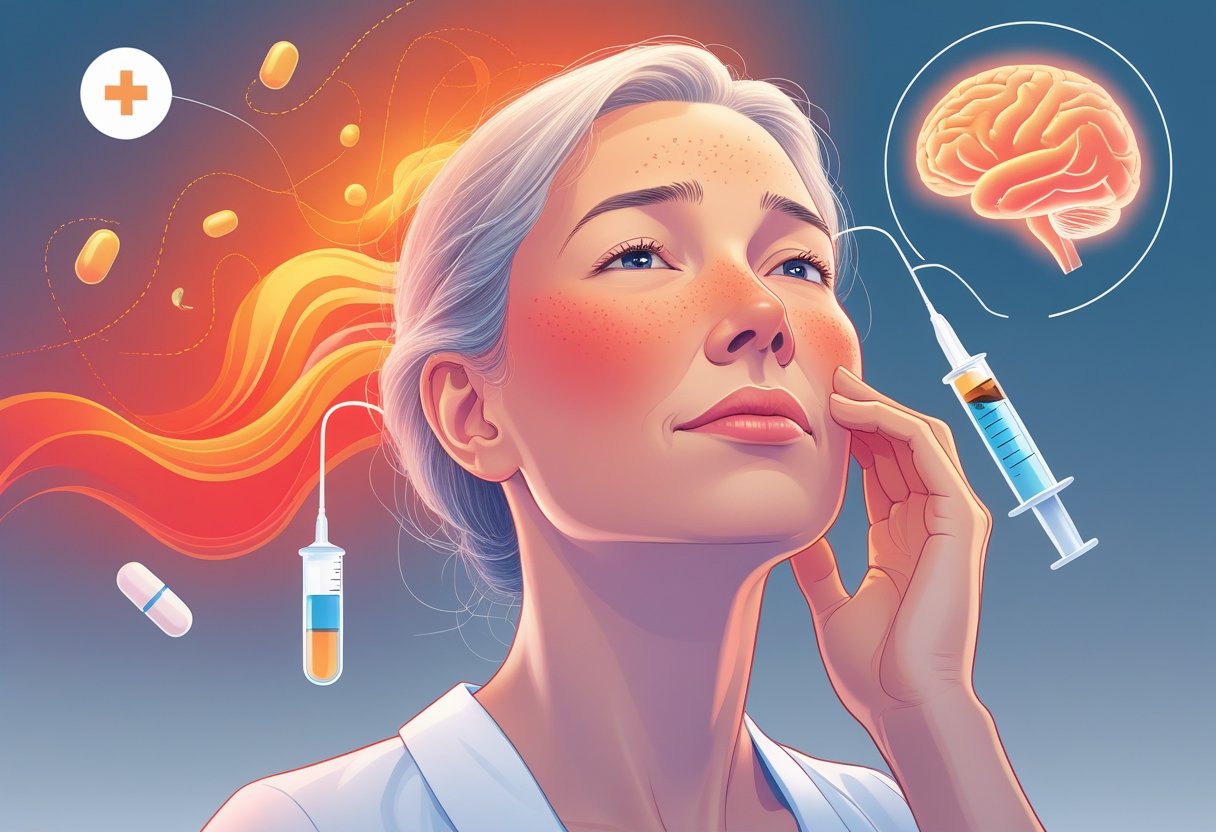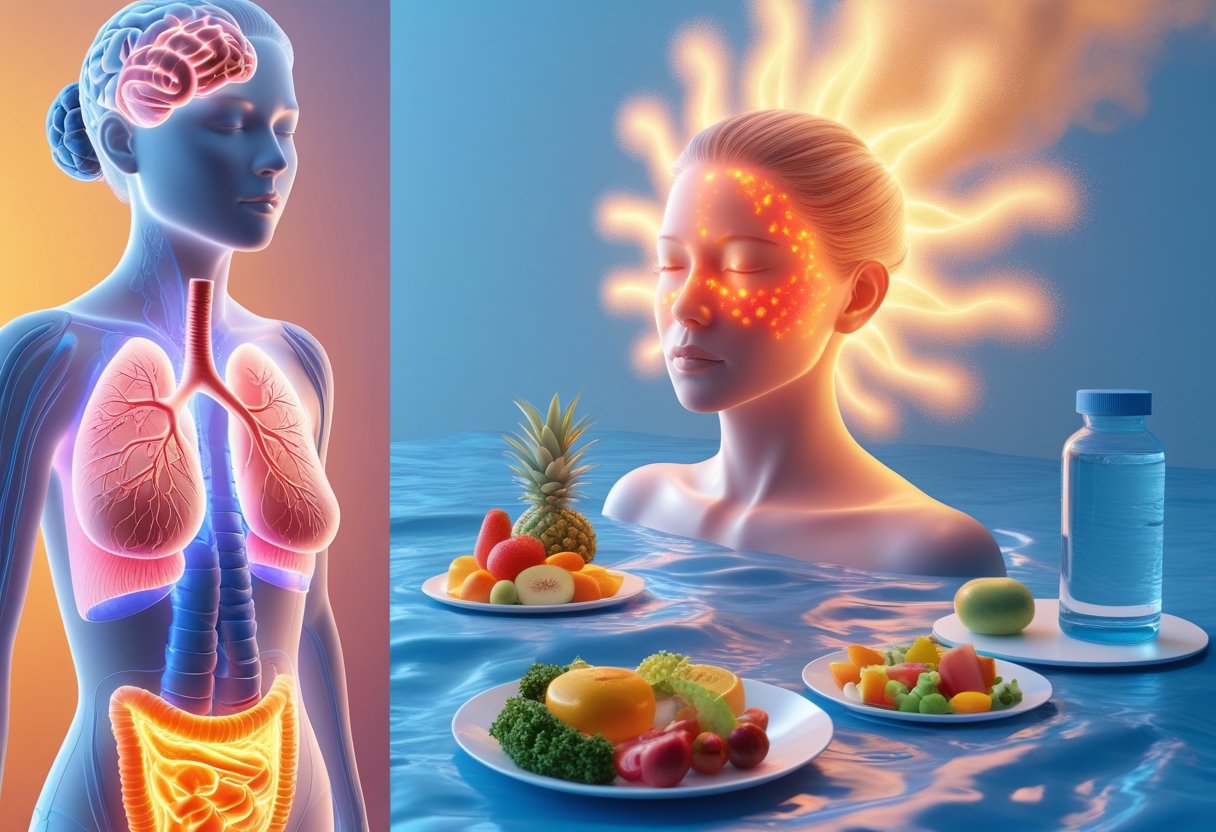Hot flashes are sudden waves of heat that often affect the face, neck, and chest. They are a common symptom linked to changes in hormone levels, especially during menopause, but they can also happen for other reasons. A hot flash usually causes intense warmth, sweating, and sometimes a rapid heartbeat, making it uncomfortable but typically harmless.

People experience hot flashes differently in how often and how severe they are. Understanding what causes these episodes can help in managing them better. Various treatments, including hormone therapy and non-hormonal options, can reduce the frequency and intensity of hot flashes for those who suffer from them.
Knowing the triggers and how to find relief is important for anyone dealing with this condition. It can improve quality of life and reduce stress related to sudden heat and discomfort.
Key Takeways
- Hot flashes cause sudden heat and sweating mainly in the upper body.
- Hormone changes are the most common cause, but other factors can trigger them too.
- Treatments range from hormone therapy to natural remedies and medications.
What Are Hot Flashes?
Hot flashes cause a sudden feeling of intense heat, mostly in the upper body. This heat often comes with visible changes like flushing and sweating. It happens because the body’s system for controlling temperature becomes less stable.
Vasomotor Symptoms Overview
Hot flashes are a type of vasomotor symptom, meaning they involve changes in the blood vessels. When a hot flash starts, blood vessels near the skin widen quickly. This widening helps the body release heat but also makes the skin red and warm.
Vasomotor symptoms usually affect the face, neck, and chest. These symptoms are common during menopause but can also happen for other reasons related to hormone changes. The intensity and frequency vary for each person.
Body Temperature Regulation
The body normally keeps its temperature steady through a system controlled by the brain. This system senses small changes in temperature and adjusts blood flow and sweating to cool or warm the body.
During hot flashes, this control system becomes more sensitive or confused. It reacts as if the body is overheated, even when it is not. This triggers sudden heat release to cool the body down, causing the person to feel an unexpected rush of warmth.
Flushing and Perspiration
Flushing is the red appearance of the skin that happens during a hot flash. It happens when blood vessels expand quickly, making the skin look flushed or blotchy. It is most noticeable on the face, neck, and chest.
At the same time, perspiration or sweating helps cool the body down. Sweating can range from light moisture to heavy drenching. Both flushing and perspiration are natural reactions tied to the body’s effort to manage the sudden rise in heat. The sweating helps reduce body temperature after blood vessels expand.
For detailed symptoms and causes, see hot flashes explained by the Mayo Clinic.
Symptoms of Hot Flashes
Hot flashes cause sudden and intense sensations of heat that affect the upper body. They often come with several physical and emotional symptoms that vary in type and severity. These symptoms can interfere with daily life and sleep.
Sweating and Night Sweats
Sweating is one of the most common symptoms during a hot flash. It may start as a light warmth on the face and neck, then quickly lead to heavy sweating. This sweating can cause discomfort and may soak clothing.
Night sweats are hot flashes that happen during sleep. They can cause a person to wake up drenched in sweat, making it hard to get restful sleep. Frequent night sweats can lead to sleep problems and fatigue during the day.
Heart Palpitations
During a hot flash, a person may feel their heart beating faster or pounding strongly. These heart palpitations can feel sudden and unsettling. They usually last only a few minutes but may increase anxiety or stress.
Palpitations are often linked to the body’s response to heat and sudden temperature changes during a hot flash. Though usually harmless, they can add to the discomfort and make the episode feel more intense.
Sleep Disturbances and Insomnia
Hot flashes can cause frequent awakenings at night due to discomfort or sweating. This interrupts the normal sleep cycle and results in poor sleep quality.
Insomnia, or difficulty falling and staying asleep, is common among people experiencing hot flashes. Lack of sleep can worsen other symptoms such as mood changes and memory problems, creating a cycle that can be hard to break.
Mood Changes and Memory Problems
Mood changes during hot flashes may include irritability, anxiety, or feelings of sadness. They might happen because the physical discomfort interferes with daily activities and rest.
Some people also notice memory problems or trouble concentrating. These cognitive issues are linked to poor sleep and hormone fluctuations occurring with hot flashes. They might make simple tasks feel harder than usual.
Causes of Hot Flashes
Hot flashes happen because of changes in the body that affect temperature control and hormone levels. These changes mostly involve estrogen and how the brain's temperature regulator responds. Understanding these causes helps explain why hot flashes appear and who is most affected.
Hormonal Changes and Estrogen Decline
Estrogen is a key hormone that affects many body functions, including temperature regulation. When estrogen levels drop, the brain’s hypothalamus, which manages body temperature, can become confused. It may trigger sudden feelings of heat to cool the body down, causing hot flashes.
This decline in estrogen can come from several sources, but it is most common during aging. Lower estrogen affects blood vessels and the nervous system, making them more sensitive. This sensitivity often leads to the quick heat bursts women feel during hot flashes.
Role of Menopause and Perimenopause
Menopause is the main stage in life when hot flashes usually begin. It marks the end of a woman’s reproductive years and a sharp drop in estrogen. However, hot flashes often start in perimenopause, the years before menopause. During perimenopause, estrogen levels go up and down unevenly.
This fluctuation makes the hypothalamus send mixed signals about body temperature. Because of this, perimenopausal women often experience more unpredictable and intense hot flashes than postmenopausal women. The body's changing hormone pattern is the main cause behind these temperature episodes during this transition.
For more details on how hormonal shifts cause hot flashes, see Hot Flashes: Triggers, How Long They Last & Treatments.
Hot Flashes in Menopause
Hot flashes are a key part of menopause. They often come with other symptoms that can affect daily life and well-being. These changes can make managing comfort and health harder for many women.
Symptoms of Menopause
Hot flashes are sudden warmth waves that spread through the body. They can last seconds to minutes and often include sweating and a red, flushed face.
Other common menopause symptoms include:
- Vaginal dryness, which may cause discomfort during sex
- Urinary incontinence, or leaking urine during activities like coughing or sneezing
- Irregular periods before they stop completely
- Night sweats, which disturb sleep and cause fatigue
These symptoms result from the drop in estrogen, a hormone that helps regulate body temperature and other functions. The frequency and intensity of hot flashes vary widely among women.
Quality of Life Impact
Hot flashes and related menopause symptoms affect many areas of daily living. Night sweats can interrupt sleep, leading to tiredness and reduced concentration.
Women may feel embarrassed or anxious about sudden hot flashes, especially in social or work settings. Vaginal dryness and urinary incontinence can reduce intimacy and cause emotional stress.
Managing these symptoms often requires lifestyle changes and, in some cases, medical treatments. Strategies like cooling techniques, regular exercise, and nonhormonal medications can help improve comfort and quality of life.
For more details on managing hot flashes, visit An Ob-Gyn's Top Tips for Managing Hot Flashes.
Hot Flashes Induced by Medical Conditions and Treatments

Certain medical conditions and their treatments can cause hot flashes by affecting hormone levels. These changes disrupt the body’s temperature control system, leading to sudden warmth and sweating. The following sections describe how specific cancers and treatments trigger hot flashes.
Breast Cancer and Cancer Treatment
Breast cancer and its treatments often cause hot flashes. Many breast cancers rely on estrogen to grow. Treatments that block or lower estrogen can trigger hot flashes as a side effect.
Patients who take drugs like tamoxifen or raloxifene, which block estrogen receptors, commonly report hot flashes. These medicines reduce estrogen’s effect, disrupting temperature regulation.
Surgery to remove ovaries or radiation therapy to the pelvic area can also cause early menopause, increasing the risk of hot flashes.
Women with breast cancer may face more intense or longer-lasting hot flashes due to these treatments and hormone changes.
Chemotherapy and Hormonal Therapy
Chemotherapy drugs kill rapidly growing cells, including those in ovaries. This often leads to a drop in estrogen production and sudden menopause. The sudden loss of estrogen from chemotherapy is a frequent cause of hot flashes.
Hormonal therapy used in cancer treatment focuses on changing hormone levels to slow tumor growth. These therapies, such as aromatase inhibitors, also lower estrogen and cause hot flashes as a common side effect.
Side effects like dizziness and tiredness from chemotherapy drugs may worsen hot flash symptoms.
Orchiectomy and Testosterone Therapy
Orchiectomy is the removal of one or both testicles. This procedure drastically lowers testosterone levels in men, which can cause hot flashes similar to those in menopausal women.
Men undergoing hormone therapy for prostate cancer may receive testosterone-blocking drugs. The loss of testosterone often leads to hot flashes, sweating, and chills.
Testosterone replacement therapy can sometimes reduce hot flashes but may not be suitable for all patients due to cancer risks.
| Cause | Effect on Hormones | Result |
|---|---|---|
| Breast cancer treatment | Estrogen blocking or lowering | Hot flashes from low estrogen |
| Chemotherapy | Ovarian damage, low estrogen | Sudden menopause, hot flashes |
| Orchiectomy | Testosterone removal | Hot flashes like menopause |
| Hormonal therapy | Blocks estrogen or testosterone | Hot flashes, sweating |
Treatment Options for Hot Flashes

Hot flashes can often be eased with simple, practical steps. Maintaining healthy habits and learning techniques to calm the body can lower the number and intensity of hot flashes.
Lifestyle Changes and Healthy Weight
Changing daily routines helps reduce hot flashes for many people. Avoiding triggers like spicy foods, alcohol, and caffeine is important. Wearing lightweight, breathable clothes can also help manage sudden heat.
Keeping a healthy weight matters because extra body fat may increase hot flash frequency. Regular exercise supports weight control and improves overall health. It also helps regulate body temperature, which can ease hot flashes.
Tracking hot flashes helps identify patterns. This allows adjustments to habits that cause flare-ups. Staying cool by using fans or cold packs during a hot flash can provide quick relief.
Deep Breathing and Meditation
Deep breathing exercises calm the nervous system, which may reduce the severity of hot flashes. Slow, steady breaths lower heart rate and help the body return to a cooler state during a hot flash.
Meditation encourages relaxation, reducing stress that can trigger hot flashes. Regular practice improves mindfulness, making it easier to manage symptoms when they occur.
Simple steps like inhaling for four counts, holding for four, and exhaling for four can be done anywhere. These techniques are safe and have no side effects, making them useful tools alongside other treatments.
For more on managing hot flashes, see treatment options involving lifestyle and medical therapies at Cleveland Clinic.
Hormone Therapy and Alternatives
Hormone therapy can help manage hot flashes by adjusting hormone levels that drop during menopause. Treatments include replacing estrogens or combining them with other hormones. Several prescription medications target symptoms based on individual health needs.
Hormone Replacement Therapy (HRT) and Estrogens
Hormone replacement therapy (HRT) uses estrogens to relieve hot flashes by restoring hormone balance. It is often the most effective option and can be given as pills, patches, gels, or creams. Estrogen therapy specifically raises low estrogen levels, reducing hot flash frequency and severity.
HRT is usually recommended for women without a history of breast cancer or blood clots. It works best if started near menopause. Doctors tailor doses to the lowest effective amount to minimize side effects.
Women using estrogen therapy should be monitored regularly due to risks like stroke, heart disease, and certain cancers. However, many find the symptom relief worth these risks under proper care.
Progesterone and Estradiol
Progesterone is often combined with estrogen in hormone therapy to protect the uterus from cancer caused by estrogen alone. This combination helps balance hormone levels and reduce hot flashes.
Estradiol is a common and potent form of estrogen used in treatments. It closely mimics the body’s natural estrogen and can be given alone or with progesterone.
Some women receive estradiol patches or pills, which may have fewer side effects than other forms. Progesterone can be delivered as pills, injections, or creams to support estrogen therapy safely.
Duavee and Other Prescription Medications
Duavee combines estrogen with bazedoxifene, a medication that blocks estrogen’s effect on the uterus without using progesterone. This reduces risks linked to estrogen-only therapy.
Duavee treats hot flashes and also helps prevent bone loss in postmenopausal women. It is one option for women who need hormone therapy but want alternatives to progesterone.
Other prescription medications include antidepressants and gabapentin, which can decrease hot flashes without hormones. These are useful for women who cannot take hormone therapy due to health risks.
For more detailed treatment choices, see hormone replacement therapy for menopause symptoms.
Non-Hormonal Medications for Hot Flashes
Non-hormonal medications offer several treatment options for managing hot flashes, especially for those who cannot or prefer not to use hormone therapy. These drugs work by affecting brain chemicals or nervous system signals linked to hot flashes. They vary in type, how they work, and possible side effects.
Selective Serotonin Reuptake Inhibitors (SSRIs)
Selective serotonin reuptake inhibitors (SSRIs) are often used to treat depression but can also reduce hot flashes. They work by increasing serotonin levels, which helps regulate body temperature. Paroxetine is the most well-known SSRI approved specifically for hot flashes.
Paroxetine is available under the brand name Brisdelle and is the only nonhormonal treatment approved by the FDA for this purpose. It is usually taken daily in a low dose. Other SSRIs like escitalopram have also been shown to help, though they are not officially approved for hot flashes.
Common side effects include nausea, fatigue, and dizziness. SSRIs may interact with other medications, so healthcare providers monitor patients closely during treatment.
Serotonin-Norepinephrine Reuptake Inhibitors (SNRIs)
Serotonin-norepinephrine reuptake inhibitors (SNRIs) help reduce hot flashes by adjusting the levels of both serotonin and norepinephrine in the brain. Venlafaxine is the most studied SNRI for this use.
Venlafaxine can decrease the frequency and severity of hot flashes. It is taken in pill form, typically once or twice a day. This medication is an option for those who do not want hormone therapy or cannot take SSRIs.
Side effects may include headache, dry mouth, and increased blood pressure. Patients often start at a low dose, which is gradually increased to reduce side effects.
Gabapentin and Clonidine
Gabapentin, originally used for nerve pain and seizures, has been shown to reduce hot flashes by calming nerve signals in the brain. It is often chosen when SSRIs or SNRIs are not suitable.
Gabapentin is usually taken three times a day. It works better for some people than others and may cause dizziness or fatigue.
Clonidine, a blood pressure medicine, can also reduce hot flashes by affecting the nervous system. It is less effective than other options but may help if other drugs are not tolerated.
Common side effects of clonidine include dry mouth, drowsiness, and low blood pressure. It is usually given as a patch or pill.
Fezolinetant and Brisdelle
Fezolinetant is a newer, non-hormonal drug designed specifically for hot flashes. It works by blocking a brain pathway involved in temperature regulation. Unlike SSRIs or SNRIs, fezolinetant targets the root cause of hot flashes with fewer side effects related to mood.
Patients take fezolinetant once daily in pill form. It has been FDA-approved and offers an alternative for those who cannot use hormone therapy or traditional antidepressants.
Brisdelle is a brand name for low-dose paroxetine. It remains a widely used SSRI option because of its FDA approval specifically for menopausal hot flashes. Both drugs are important options depending on patient needs and medical history.
These medications provide varying choices based on patient health, side effects, and preferences.
Supplements and Natural Remedies
Many people use supplements to help reduce hot flashes. Some popular options include black cohosh, which may have estrogen-like effects to ease symptoms. Others try evening primrose oil for its potential to improve comfort during menopause.
Red clover and flaxseed are also common. Red clover contains plant compounds that may affect hormones. Flaxseed might help with night sweats by providing natural oils and fiber.
A blend of amino acids and minerals like Amberen aims to restore hormonal balance and reduce hot flashes. However, results can vary for each person.
Non-supplement remedies include lifestyle changes like wearing cotton clothing and practicing yoga or meditation. These methods help some people manage stress and cool their body naturally.
Here’s a quick look at common supplements for hot flashes:
| Supplement | Purpose | Notes |
|---|---|---|
| Black cohosh | May reduce hot flashes | Possible estrogen-like effects |
| Evening primrose oil | May ease symptoms | Often used for menopause |
| Red clover | Contains plant estrogens | Limited evidence |
| Flaxseed | Helps with night sweats | Provides omega-3 and fiber |
| Amberen | Hormonal balance blend | Mix of amino acids and minerals |
People should talk to a doctor before starting supplements, especially if they take other medicines or have health conditions. Some herbs can interact with medications or cause side effects.
More details on natural options are available in this article on natural remedies for hot flashes.
Mental Health and Hot Flashes
Hot flashes are linked to changes in mental health for many women during menopause. Mood shifts and emotional symptoms often happen alongside physical signs like hot flashes. Understanding how depression and anxiety interact with hot flashes can help manage both conditions.
Depression and Anxiety
Women with depression are more likely to experience hot flashes. Depression can make the body react to stress differently, increasing the frequency or intensity of hot flashes.
Anxiety also plays a strong role. Sometimes anxiety triggers hot flashes, and other times hot flashes cause anxiety. This creates a cycle where one makes the other worse. Anxiety can increase sweating, heart rate, and feelings of discomfort during hot flashes.
Some antidepressants may help reduce hot flashes, but treatments need to be carefully balanced to manage both mood and physical symptoms. This connection between mental health and hot flashes affects sleep quality and overall well-being during menopause.
More on the link between hot flashes and mood can be found in this article about the relationship between hot flashes, anxiety, and menopause.
Frequently Asked Questions
Hot flashes usually involve sudden warmth and sweating in the upper body. They can happen for different reasons and may vary in how long they last or how often they occur. Some lifestyle and dietary choices can affect these symptoms too.
What are the common symptoms of hot flashes?
Hot flashes cause a sudden feeling of heat in the face, neck, and chest. People often experience sweating, redness, and sometimes chills after the heat fades. These episodes can last from a few seconds to several minutes.
Are hot flashes indicative of any serious health conditions?
Hot flashes are most commonly linked to menopause but are not usually a sign of serious illness. However, if hot flashes are very frequent or severe, it’s important to see a healthcare provider to rule out other causes or health issues.
What dietary changes can help manage hot flashes?
Avoiding spicy foods, caffeine, and alcohol may reduce hot flashes. Eating a balanced diet rich in fruits, vegetables, and whole grains can support overall health. Some find relief by staying hydrated and maintaining a healthy weight.
Can men experience hot flashes, and what causes them in males?
Yes, men can have hot flashes. They may happen due to low testosterone levels, especially during treatments for prostate cancer or with hormonal changes. Hot flashes in men have similar symptoms to those in women.
What are the effective treatments to stop hot flashes quickly?
Hormone therapy is often used to reduce hot flashes, but nonhormonal options like certain antidepressants or lifestyle changes can help too. Cooling techniques and wearing loose clothing may provide immediate relief during an episode.
Why might someone experience hot flashes in their 20s?
Hot flashes in younger people can be caused by stress, certain medications, or medical conditions affecting hormone levels. Sometimes they result from thyroid problems or other health issues that need medical attention.
Learn more about triggers and treatment options through Hot Flashes: Triggers, How Long They Last & Treatments.
Conclusion
Hot flashes are a common and natural symptom experienced by many women during menopause. They cause sudden feelings of heat, sweating, and flushed skin, mainly on the chest, neck, and face. These episodes can vary in frequency and duration.
Management options include lifestyle changes such as avoiding triggers like spicy food and stress. Nonhormonal medications and, in some cases, hormone therapy may also provide relief. Choosing the right approach depends on the severity of symptoms and individual health factors.
Women might benefit from tracking their hot flashes to identify patterns or triggers. Relaxation techniques and keeping cool can help reduce discomfort during episodes. Support from healthcare providers is important to create a plan suited to each person’s needs.
| Key Points About Hot Flashes |
|---|
| Sudden warmth and sweating |
| Usually affect face, neck, chest |
| Common during menopause |
| Triggered by heat, stress, certain foods |
| Managed with lifestyle changes and medication |
Understanding hot flashes helps women handle this symptom with more confidence and control. Proper care focuses on improving quality of life without unnecessary risks. For more detailed information, see this article on hot flashes.

